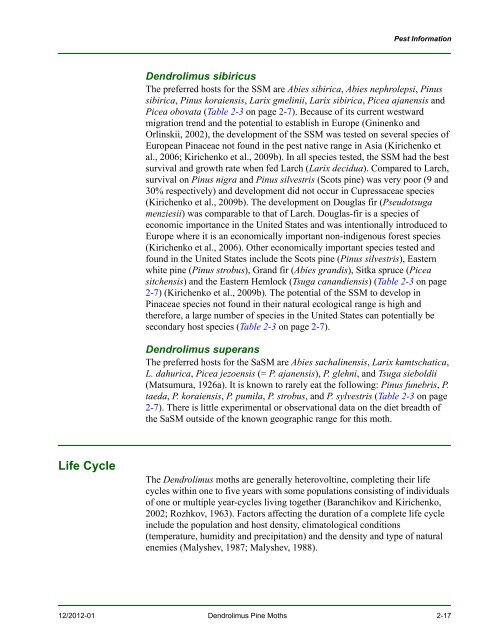New Pest Response Guidelines - aphis - US Department of Agriculture
New Pest Response Guidelines - aphis - US Department of Agriculture
New Pest Response Guidelines - aphis - US Department of Agriculture
You also want an ePaper? Increase the reach of your titles
YUMPU automatically turns print PDFs into web optimized ePapers that Google loves.
Life Cycle<br />
<strong>Pest</strong> Information<br />
Dendrolimus sibiricus<br />
The preferred hosts for the SSM are Abies sibirica, Abies nephrolepsi, Pinus<br />
sibirica, Pinus koraiensis, Larix gmelinii, Larix sibirica, Picea ajanensis and<br />
Picea obovata (Table 2-3 on page 2-7). Because <strong>of</strong> its current westward<br />
migration trend and the potential to establish in Europe (Gninenko and<br />
Orlinskii, 2002), the development <strong>of</strong> the SSM was tested on several species <strong>of</strong><br />
European Pinaceae not found in the pest native range in Asia (Kirichenko et<br />
al., 2006; Kirichenko et al., 2009b). In all species tested, the SSM had the best<br />
survival and growth rate when fed Larch (Larix decidua). Compared to Larch,<br />
survival on Pinus nigra and Pinus silvestris (Scots pine) was very poor (9 and<br />
30% respectively) and development did not occur in Cupressaceae species<br />
(Kirichenko et al., 2009b). The development on Douglas fir (Pseudotsuga<br />
menziesii) was comparable to that <strong>of</strong> Larch. Douglas-fir is a species <strong>of</strong><br />
economic importance in the United States and was intentionally introduced to<br />
Europe where it is an economically important non-indigenous forest species<br />
(Kirichenko et al., 2006). Other economically important species tested and<br />
found in the United States include the Scots pine (Pinus silvestris), Eastern<br />
white pine (Pinus strobus), Grand fir (Abies grandis), Sitka spruce (Picea<br />
sitchensis) and the Eastern Hemlock (Tsuga canandiensis) (Table 2-3 on page<br />
2-7) (Kirichenko et al., 2009b). The potential <strong>of</strong> the SSM to develop in<br />
Pinaceae species not found in their natural ecological range is high and<br />
therefore, a large number <strong>of</strong> species in the United States can potentially be<br />
secondary host species (Table 2-3 on page 2-7).<br />
Dendrolimus superans<br />
The preferred hosts for the SaSM are Abies sachalinensis, Larix kamtschatica,<br />
L. dahurica, Picea jezoensis (= P. ajanensis), P. glehni, and Tsuga sieboldii<br />
(Matsumura, 1926a). It is known to rarely eat the following: Pinus funebris, P.<br />
taeda, P. koraiensis, P. pumila, P. strobus, and P. sylvestris (Table 2-3 on page<br />
2-7). There is little experimental or observational data on the diet breadth <strong>of</strong><br />
the SaSM outside <strong>of</strong> the known geographic range for this moth.<br />
The Dendrolimus moths are generally heterovoltine, completing their life<br />
cycles within one to five years with some populations consisting <strong>of</strong> individuals<br />
<strong>of</strong> one or multiple year-cycles living together (Baranchikov and Kirichenko,<br />
2002; Rozhkov, 1963). Factors affecting the duration <strong>of</strong> a complete life cycle<br />
include the population and host density, climatological conditions<br />
(temperature, humidity and precipitation) and the density and type <strong>of</strong> natural<br />
enemies (Malyshev, 1987; Malyshev, 1988).<br />
12/2012-01 Dendrolimus Pine Moths 2-17

















